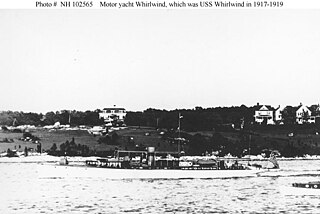
USS Winchester (SP-156) was an armed yacht that served in the United States Navy as a patrol vessel from 1917 to 1919. Prior to and following World War I, Winchester was a private yacht, later renamed Renard. In World War II, Renard was requisitioned for use in the Royal Canadian Navy as a patrol vessel, keeping her name. She was returned to her owners in 1944.

USS Helenita (SP-210) was a yacht leased from its owner by the U.S. Navy during World War I. She was outfitted as an armed patrol craft and initially assigned to North Atlantic Ocean duty, but found to be too lightly built for the ocean. She was then relegated to patrol of Long Island Sound and the Delaware Bay until war's end, when her guns were removed and she was returned to her owner.

USS Utowana (SP-951) – also known as USS Victorine (SP-951) -- was a fishing trawler acquired by the U.S. Navy during World War I. The Navy had planned to use her as a minesweeper based out of Kittery, Maine; however, Utowana spent most of her service time operating as an armed patrol craft, responsible for escorting Allied ships across the dangerous North Atlantic Ocean. She served through the war and the armistice before returning to the United States for decommissioning.
USS Helena I (SP-24) was an armed yacht that served the United States Navy as a patrol vessel from 1917 to 1919.

The first USS Mustang (SP-36) was an armed yacht that served in the United States Navy as a patrol vessel from 1917 to 1919.

USS Gem (SP-41) was an armed yacht that served in the United States Navy as a patrol vessel from 1917 to 1919.

USS Despatch (SP-68), later PY-8, originally USS Vixen (SP-68), was a steam yacht that served in the United States Navy as a tender from 1917 to 1919 and from 1920 to 1921.

USS Joyance (SP-72) was an armed yacht that served in the United States Navy as a patrol vessel from 1917 to 1919.

USS Coco (SP-110) was an armed motorboat that served in the United States Navy as a Section patrol vessel from 1917 to 1919.

USS Taniwha (SP-129) was an armed yacht that served in the United States Navy as a patrol vessel from 1917 to 1919.

The second USS Sovereign (SP-170) was an armed yacht that served in the United States Navy as a patrol vessel from 1918 to 1919.

The first USS Whirlwind (SP-221) was a United States Navy patrol vessel in commission in 1917 and again in 1918.

The first USS Sabalo (SP-225) was a United States Navy patrol vessel in commission from 1917 to 1919. Following World War I, Sabalo was sold to private interests before returning to service as a patrol vessel in World War II, this time with the Royal Canadian Navy, renamed Cougar. Returning to private ownership following the war, the vessel sank in a hurricane in 1950.

USS Aloha (SP-317) was a United States Navy patrol vessel in commission from 1917 to 1919.

USS Cigarette (SP-1234) was a patrol vessel that served in the United States Navy from 1917 to 1919.

USS Vivace (SP-583) was a United States Navy patrol vessel in commission from 1917 to 1918.

USS Raeo (SP-588) was a United States Navy patrol vessel in commission from 1917 to 1919. Prior to her U.S. Navy service, she operated as the motor passenger vessel Raeo from 1908 to 1917. After the conclusion of her U.S. Navy career, she served as the fishery patrol vessel USFS Kittiwake in the United States Bureau of Fisheries fleet from 1919 to 1940 and as US FWS Kittiwake in the Fish and Wildlife Service fleet from 1940 to 1942 and from 1944 to at least 1945, and perhaps as late as 1948. During World War II, she again served in the U.S. Navy, this time as the yard patrol boat USS YP-199. She was the civilian fishing vessel Raeo from 1948 to 1957, then operated in various roles as Harbor Queen from 1957 to 1997. She became Entiat Princess in 1998 and as of 2009 was still in service.

USS Talofa (SP-1016) was a United States Navy patrol vessel in commission from 1917 to 1919.
USS Herman S. Caswell (SP-2311) was a United States Navy patrol vessel in service from 1918 to 1919.

USS Audwin (SP-451) was a patrol vessel that served in the United States Navy from 1917 to 1919. She then was a survey vessel in the United States Coast and Geodetic Survey from 1919 to 1927.


















